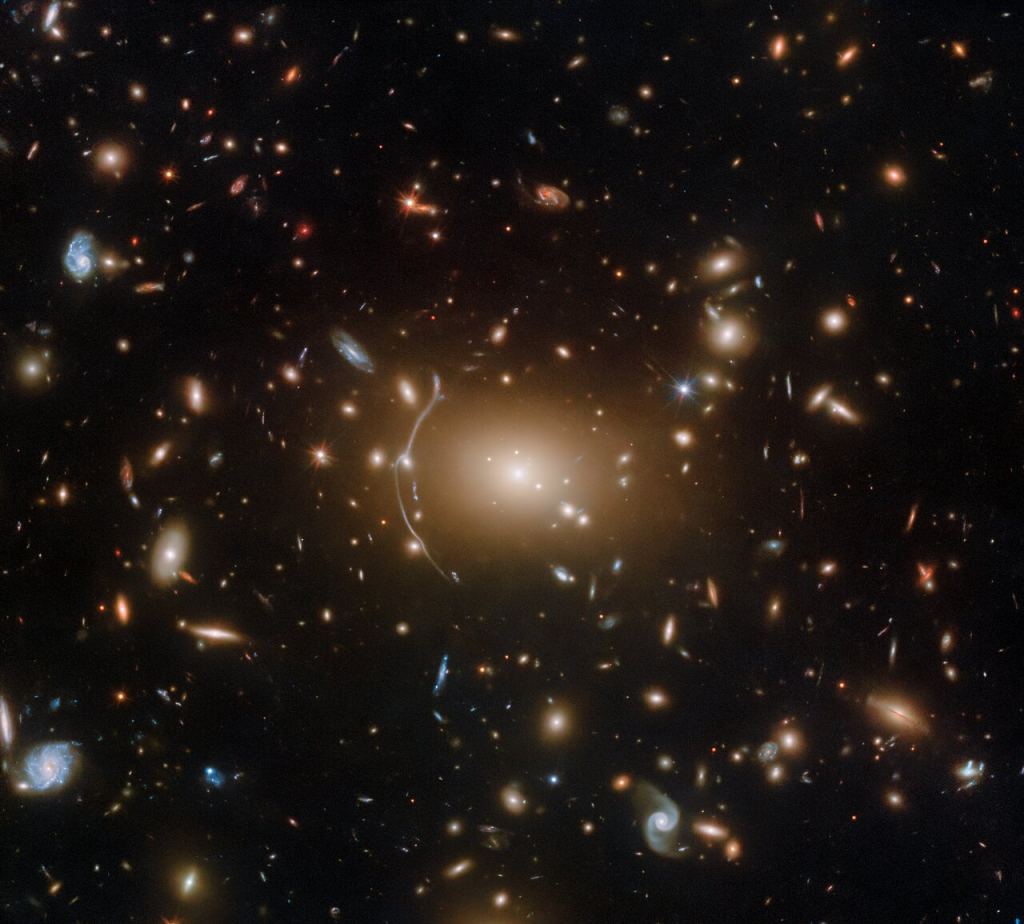Dark matter. It’s secret. It’s dark because it doesn’t give off any light.
We can’t see it, taste it, touch it, smell it, or even feel it. But, astronomers can measure this dark secret of the universe. How? By looking at galaxies and galaxy clusters.
Dark matter exerts a gravitational influence on those regions, and that CAN be measured. Just take a look at this image of Abell 611. It’s a galaxy cluster that lies about 3.
2 billion light-years away from us. At first glance you think, “yeah, it’s a cluster of galaxies, so what?” For astronomers though, this cluster poses a challenge. They know from measuring it that there’s not enough mass in the galaxies and the cluster to keep the whole thing from flying apart.
Therefore, gravity must be holding it together. But, where’s the “stuff” that has the gravitational influence? It’s not just the stuff we can see in the galaxies. It must also be dark matter.
The Cosmic Stuff that Confounds Understanding The existence of galaxies and clusters that aren’t flying apart is a well-known challenge to astronomers, and not just in Abell 611. Astronomer Vera Rubin and her team tackled the mismatch between a galaxy’s rotation rate and its mass back in the mid-20th century. They observed galaxies that seem to have more mass than their rotation speeds would suggest.
It wasn’t a new problem—astronomer Fritz Zwicky found Hubble’s observations of the Coma Cluster of galaxies puzzling back in the 1930s. Some galaxies in that cluster appear to be moving too fast and that should have blown the cluster apart. Zwicky puzzled over it and decided that some unknown thing he called “dunkle Materie” (dark matter) might explain the anomaly.
Today, astronomers still grapple with understanding this cosmic “stuff. ” Not just because galaxy clusters aren’t flying apart. Or that galaxies aren’t either.
It appears that the universe is not just stars and galaxies and nebulae and planets. About 85 percent of the mass in the Universe is dark matter. Compare that to the mass we can see—also known as normal matter or baryonic matter.
That comprises only about 5 percent. A computer simulation of the distribution of matter in the universe. Orange regions host galaxies; blue structures are gas and dark matter.
Credit: TNG Collaboration So, we know it’s there in most (but not all) galaxies. But what IS dark matter? A lot of theories abound, but they boil down to two possibilities. It could be a type of particle that exists all over the Universe but doesn’t interact with light.
Or, it might consist of an extensive population of massive objects that can’t be detected with our current technology. So, they’re either WIMPs (weakly interacting massive particles) or MACHOs (massive astrophysical compact halo objects. Astronomers have looked all over for these things.
So far, no credible detections exist, other than to note that whatever this stuff is, it’s keeping galaxies and clusters from disintegrating. Dark Matter and Clusters And, that brings us back to Abell 611. It’s actually a good test subject for the idea of dark matter.
Astronomers know that galaxies and clusters are dominated by their dark matter components. In Abell 611, the cluster’s appearance provides evidence for astronomers to measure the amount of dark matter there. Gravitational lensing, for example, is the best visible evidence.
The curves of light within the cluster are actually images of more distant galaxies whose light is being distorted by gravity as it passes through. The mass of the galaxies in the cluster isn’t enough to make those distortions. So, something else has to be doing it—and that would be dark matter in the cluster.
The galaxy cluster SMACS 0723 as seen by NIRCam on JWST. Gravitational lensing properties (from its mass and from the mass of dark matter) are helping astronomers identify 88 distant galaxies in this field of view for further study. Courtesy NASA, ESA, CSA, STScI In fact, clusters across the Universe show this effect of dark matter haloes surrounding them.
One of JWST’s first images shows the gravitational lensing caused by the halo around the cluster SMACS J0723. 3-7327. It has thousands of galaxies surrounded by a dark matter halo.
Each galaxy also has a component of dark matter. The result is the amazing display of lensed galaxies seen in the image. They all lie at extreme distances behind the SMACS cluster, and their light is smeared into arcs by the gravitational domination of the dark matter.
The fact that this same scene plays out across many clusters throughout the Universe tells us that dark matter is real, even if astronomers haven’t yet figured out what it is. For More Information A Cosmic CobwebDark Energy, Dark MatterSeparating Galaxies from the Cluster Dark Matter Halo in Abell 611 The post In a New Hubble Image, Dark Matter Anchors the Giant Galaxy Cluster Abell 611 appeared first on Universe Today. .
From: universetoday
URL: https://www.universetoday.com/158413/in-a-new-hubble-image-dark-matter-anchors-the-giant-galaxy-cluster-abell-611/



